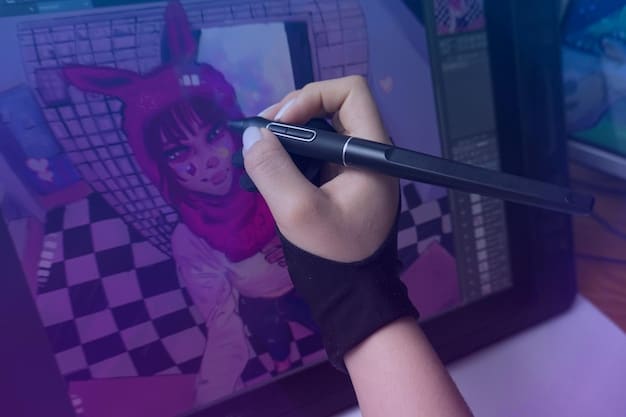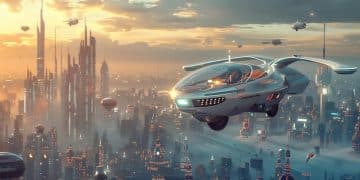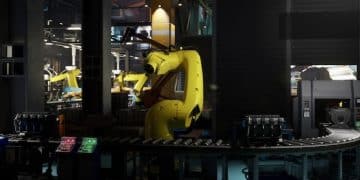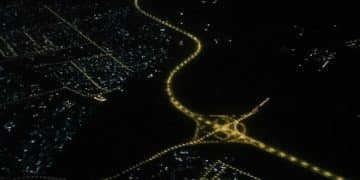The Evolution of Animation: Technology Shaping Future Cartoons

The continuous evolution of animation is intrinsically linked to technological advancements, radically transforming traditional methods and opening new frontiers for creative expression that redefine how cartoons are conceived, produced, and consumed globally.
In the dynamic realm of visual storytelling, few mediums have undergone such a profound transformation as animation. From rudimentary flipbooks to the sophisticated digital landscapes we see today, The Evolution of Animation: How Technology Is Shaping the Future of Cartoons is a testament to human ingenuity and relentless innovation.
The Dawn of Digital: From Hand-Drawn to Pixels
The journey of animation truly began with painstaking, frame-by-frame artistry. Each character, every background, was individually drawn and painted, a monumental task that limited production speed and creative complexity. This era, while rich in iconic works, set the stage for a revolution.
The advent of digital technology slowly but surely began to dismantle these traditional barriers. Initially, computers were used for tasks like coloring and compositing, offloading the most repetitive and time-consuming aspects of animation production. This incremental shift started reshaping workflows and allowing artists to focus more on the creative aspects.
Early Digital Tools and Their Impact
The first significant digital strides were seen in the late 1980s and early 1990s. Software like CAPS (Computer Animation Production System) developed by Pixar and Disney revolutionized how hand-drawn animations were processed, leading to a significant increase in efficiency and consistency.
- Digital Ink and Paint: Replaced physical cel painting, eliminating toxic materials and allowing for more consistent colors and faster revisions.
- Digital Compositing: Allowed different layers of animation (characters, backgrounds, special effects) to be combined seamlessly with greater precision.
- Reduced Production Time: Automating repetitive tasks drastically cut down the time required to complete animated features and television series.
Soon, the focus shifted from aiding traditional animation to creating entirely new forms. The transition from 2D drawn animation to 3D computer-generated imagery (CGI) was perhaps the most pivotal moment, opening up a universe of possibilities that were previously unimaginable. This fundamental change not only streamlined the production process but also laid the groundwork for an entirely new aesthetic in animated storytelling.
The early digital tools, while rudimentary by today’s standards, were disruptive. They allowed animators to experiment with new perspectives, complex camera movements, and environmental details that were prohibitively expensive or impossible to achieve traditionally. This initial embrace of digital workflows marked the true beginning of the modern animation era, laying a solid foundation for the subsequent technological leaps.
The Rise of CGI: A New Dimension in Storytelling
The breakthrough moment for computer-generated imagery came with films like Pixar’s “Toy Story” in 1995. This film was a cultural phenomenon, not just for its compelling narrative, but for proving the viability and artistic potential of fully CGI-animated features. It heralded a new era where 3D models replaced hand-drawn characters, and virtual environments built from polygons became the norm.
CGI offered unprecedented control over camera angles, lighting, and textures, allowing for a level of realism and immersion that hand-drawn animation struggled to achieve. The ability to manipulate digital puppets in a three-dimensional space changed the very methodology of character performance, bringing animated characters to life with newfound expressiveness.
Advancements in Character Rigging and Simulation
Central to the success of CGI is the sophisticated process of character rigging, which involves creating a digital skeleton (rig) that animators manipulate to pose and move characters. Advancements in rigging software have made characters more flexible and expressive than ever before.
- Inverse Kinematics (IK): Simplifies animation by allowing animators to pose a limb by moving its endpoint, with the software calculating the necessary joint rotations.
- Facial Rigging: Complex systems enable animators to create a vast range of nuanced facial expressions, crucial for conveying emotion.
- Cloth and Hair Simulation: Sophisticated algorithms now realistically simulate the movement of fabric and hair, adding another layer of realism and dynamism to characters.
Beyond character performance, CGI has also refined the creation of intricate environments and special effects. From realistic water simulations to dynamic explosions, the fidelity of digital effects has become almost indiscernible from live-action. This capability has not only benefited animated films but has also revolutionized special effects in live-action cinema, blurring the lines between the two mediums.
The iterative nature of digital creation also allowed for faster revisions and refinements. Unlike traditional animation where changes meant redrawing frames, CGI allowed for adjustments to be made to 3D models or environments with relative ease, accelerating the production pipeline. This flexibility empowers creators to experiment more freely, leading to more polished and visually stunning results.
Unreal Engine & Real-Time Rendering: The Game Changer

Traditionally, rendering animation was an extremely time-consuming and resource-intensive process. Each frame, often taking hours or even days to compute, meant that animators had to wait for final renders to see the full impact of their work. This bottleneck significantly slowed down production workflows and limited creative iteration.
Enter real-time rendering, spearheaded by game engines like Unreal Engine and Unity. What began as tools for interactive video games has now become a powerful force in film and television animation. Real-time rendering allows animators to see their creations in near-final quality instantly, fundamentally transforming the speed and efficiency of production.
Advantages of Real-Time Pipelines
The ability to visualize changes instantly offers a multitude of benefits, from faster feedback loops to more agile creative processes.
- Instant Feedback: Animators can immediately see how lighting, textures, and character movements interact, saving countless hours of rendering time.
- Virtual Production: Real-time engines enable virtual production, where filmmakers can shoot actors against virtual backgrounds that update live, akin to sophisticated green screen technology.
- Cost Efficiency: Reducing rendering times translates directly into significant cost savings, making high-quality animation more accessible.
The impact of real-time rendering extends beyond just speed. It fosters a more collaborative environment where directors, animators, and cinematographers can work simultaneously on a scene, making real-time adjustments and exploring creative options on the fly. This integration of design and execution fundamentally changes the creative workflow, allowing for greater spontaneity and artistic exploration.
Furthermore, real-time engines have democratized animation production. While still requiring powerful hardware, these engines are becoming more accessible, allowing smaller studios and independent creators to produce high-quality animated content that rivals traditional studio productions. This shift opens doors for new voices and diverse storytelling, accelerating the pace of innovation in the animation industry.
AI and Machine Learning: Automating and Enhancing Creativity
The integration of Artificial Intelligence (AI) and Machine Learning (ML) into the animation pipeline represents one of the most exciting and transformative developments. Far from replacing human artists, AI tools are designed to automate repetitive tasks, generate preliminary concepts, and enhance the quality and efficiency of the creative process.
AI can analyze vast datasets of existing animation to learn patterns, styles, and character movements. This capability allows it to assist with tasks such as in-betweening (generating frames between key poses), automated lip-syncing, and even character design variations. The goal is to free up animators to focus on the more nuanced and artistically challenging aspects of their work.
AI’s Role in Modern Animation Workflows
From pre-production to post-production, AI is slowly permeating various stages, offering powerful new capabilities.
- Generative AI for Concept Art: AI models can rapidly generate mood boards, character designs, and environment concepts based on textual prompts, accelerating the initial ideation phase.
- Automated Rigging and Skinning: AI can significantly speed up the tedious process of rigging characters and creating seamless skin deformations.
- Motion Capture Data Cleaning: ML algorithms can refine raw motion capture data, removing noise and smoothing out irregularities, leading to more natural character movements.
Beyond automation, AI is also being used to enhance realism and visual fidelity. Deep learning techniques can be applied to super-resolution, upscaling low-resolution assets without losing detail, or generating hyper-realistic textures and environmental elements. This allows for stunning visual quality even with limited initial resources.
The ethical implications and creative boundaries of AI in animation are still being explored. While AI can certainly generate impressive results, the core of compelling animation still lies in human creativity, emotion, and storytelling. AI is emerging as a powerful assistant, amplifying human potential rather than substituting it, opening new avenues for efficiency and artistic discovery in the field.
Virtual Reality (VR) & Augmented Reality (AR): Immersive Animation Experiences
Beyond the screen, virtual reality (VR) and augmented reality (AR) are poised to redefine how audiences interact with animated content. These immersive technologies offer new paradigms for storytelling, drawing viewers into worlds that are no longer confined to a static display but can be explored and experienced firsthand.
VR allows audiences to step inside animated narratives, experiencing environments and characters in 360 degrees. This provides an unprecedented sense of presence and interactivity, moving beyond passive viewing to active participation. Imagine walking through an animated forest or interacting with your favorite cartoon character in their world.
New Frontiers in Immersive Storytelling
AR, on the other hand, superimposes digital content onto the real world. This technology can bring animated characters and objects into a user’s physical environment, blurring the lines between fiction and reality, and offering unique interactive opportunities.
- Interactive Narratives: VR experiences can be designed with branching storylines based on user choices, creating personalized animated adventures.
- Educational Content: AR offers compelling ways to bring animated lessons and characters into classrooms or homes, making learning more engaging.
- Live Immersive Events: Animated characters can perform in live VR concerts or events, allowing fans to feel part of the experience.
The development of haptic feedback suits and advanced motion controllers further enhances the immersive qualities of VR animation, offering tactile sensations that correspond to digital interactions. This multi-sensory engagement deepens the emotional connection between the audience and the animated world.
While still in their nascent stages for widespread animation consumption, VR and AR represent a significant shift in audience engagement. They challenge traditional narrative structures and offer animators a new canvas for creative expression, moving animation beyond linear storytelling into fully interactive and experiential formats, promising a future of truly participative animated journeys.
The Future Is Now: Emerging Technologies and Trends
The trajectory of animation technology continues its rapid ascent, driven by a confluence of innovations. Beyond the established advancements, several emerging technologies are poised to shape the next wave of cartoons, pushing boundaries of realism, interactivity, and creative freedom. The animation landscape of tomorrow promises to be even more dynamic and visually stunning.
One significant trend is the continued integration of haptics and multi-sensory feedback within animated experiences. As animation moves into VR and AR, the ability to feel textures, vibrations, and even temperature changes within a virtual environment will deepen immersion, making animated worlds more tangible and believable for the audience. This level of sensory feedback transforms passive viewing into a holistic experience.
Key Technologies on the Horizon
Several cutting-edge technologies are already showing immense promise for future animation pipelines, fostering new creative avenues and efficiencies.
- Volumetric Capture: Capturing real-world performances in 3D, allowing for photorealistic animation of human actors that can be integrated seamlessly into animated environments.
- Neural Rendering: Using neural networks to generate highly realistic images or video from 3D models with unprecedented speed and fidelity, potentially revolutionizing real-time rendering.
- Blockchain for Asset Management: Using decentralized ledgers to securely track and manage animation assets, ensuring provenance and facilitating collaborative production across studios worldwide.
- Interactive Storytelling Frameworks: Development of standardized tools for creating non-linear, interactive animated narratives, enabling audiences to influence plot developments.
Another area of rapid development is the democratization of animation tools. As powerful software becomes more accessible and intuitive, a new generation of creators, from indie animators to enthusiasts, will gain the ability to produce high-quality content. This grassroots innovation will diversify storytelling and push the aesthetic boundaries of animation even further.
Furthermore, cloud-based rendering and collaborative platforms are becoming increasingly sophisticated, enabling distributed teams to work seamlessly on complex projects regardless of their geographic location. This global connectivity fosters more diverse talent pools and accelerates production cycles, ensuring that the future of animation is not only technologically advanced but also globally collaborative and creatively expansive.
Challenges and Opportunities in a Tech-Driven Landscape
While technology has undoubtedly propelled animation into an exciting new era, it also presents a unique set of challenges alongside its vast opportunities. Navigating this evolving landscape requires continuous adaptation, foresight, and a deep understanding of both the artistic and technical demands of the medium.
One primary challenge is the steep learning curve associated with new software and pipelines. Animators and studios must constantly invest in training and equipment to stay competitive, ensuring their teams are proficient in the latest tools. This ongoing need for skills development can be a significant resource drain, particularly for smaller independent studios.
Navigating the New Frontiers
Despite the challenges, the opportunities for innovation and growth are immense, especially for those willing to embrace change and explore new creative territories.
- Maintaining Artistic Integrity: The risk of technology overpowering artistic vision; the need to ensure tools serve creativity, not dictate it.
- Data Security and Asset Management: Securing valuable digital assets and managing complex workflows in a cloud-based, distributed production environment.
- Talent Development: Attracting and nurturing talent with skills in both traditional animation principles and emerging technologies like AI/ML and real-time engines.
Another crucial consideration is the cost barrier. While some tools are becoming more accessible, highly specialized hardware and software for cutting-edge animation remain expensive. This can create a divide between well-funded studios and independent creators, potentially limiting diversity in storytelling and production quality.
However, these challenges also spur innovation. The demand for more efficient and cost-effective solutions drives the development of open-source tools, more powerful cloud computing services, and collaborative platforms that democratize access to high-end animation capabilities. This dynamic interplay between challenge and innovation ensures that the animation industry remains vibrant and responsive, perpetually pushing the boundaries of what is possible in animated storytelling.
| Key Innovation | Brief Impact |
|---|---|
| 🎨 Digital Transition | Automated ink & paint, reduced production time for hand-drawn animation. |
| ✨ CGI Adoption | Enabled 3D modeling, realistic lighting, and complex camera movements. |
| ⚡ Real-Time Rendering | Shortened production feedback loops, improved efficiency and collaboration. |
| 🧠 AI & Machine Learning | Automated repetitive tasks, enhanced visual quality, and concept generation. |
Frequently Asked Questions About Animation Technology
▼
AI has significantly streamlined character animation by automating repetitive tasks like in-betweening, which generates frames between key poses. It also enhances lip-syncing accuracy and can even suggest nuanced facial expressions, allowing animators to focus more on the artistic performance and storytelling rather than manual frame adjustments.
▼
Virtual production integrates virtual environments with live-action filmmaking, often using real-time game engines. For animation, it means filmmakers can see actors perform within a real-time animated background, providing instant feedback on blocking, camera angles, and lighting, thus accelerating creative decisions and reducing costly post-production changes.
▼
Absolutely. While technology has evolved, traditional hand-drawn animation principles remain fundamental to character movement and expression. Many modern animated features, even those heavily reliant on CGI, incorporate elements of 2D or use a hybrid approach, demonstrating that artistic understanding is still crucial despite technological advancements. The aesthetic continues to be cherished.
▼
VR and AR transform animation from passive viewing to immersive experiences. VR allows audiences to step into animated worlds, enabling interactive narratives and exploration. AR overlays animated characters onto the real world, creating unique interactive learning opportunities, and novel ways for brands to engage with their audiences in a mixed-reality environment.
▼
The biggest challenge for animators is the continuous need for training and adaptation. The rapid pace of technological innovation means constantly learning new software, pipelines, and techniques. This requires significant investment in time and resources, demanding a blend of traditional artistic skills with a strong technical aptitude to remain competitive.
Conclusion
The journey of animation has always been intertwined with technological progress, a symbiotic relationship that continues to redefine its possibilities. From the early digital tools that streamlined production to the transformative impact of CGI, real-time rendering, AI, and immersive VR/AR experiences, technology has consistently pushed the boundaries of what is creatively achievable. While challenges such as skill adaptation and investment persist, the future of cartoons promises to be more dynamic, interactive, and visually breathtaking than ever before, driven by an insatiable quest for innovation and storytelling excellence.





